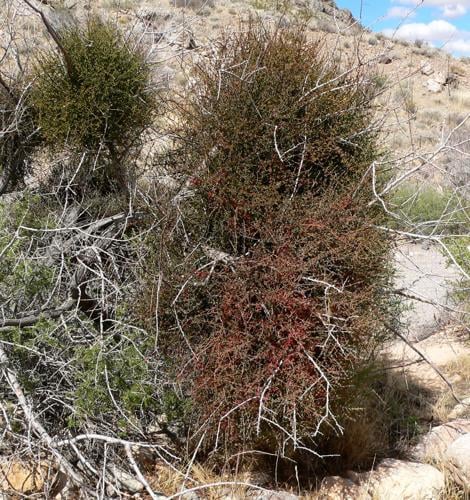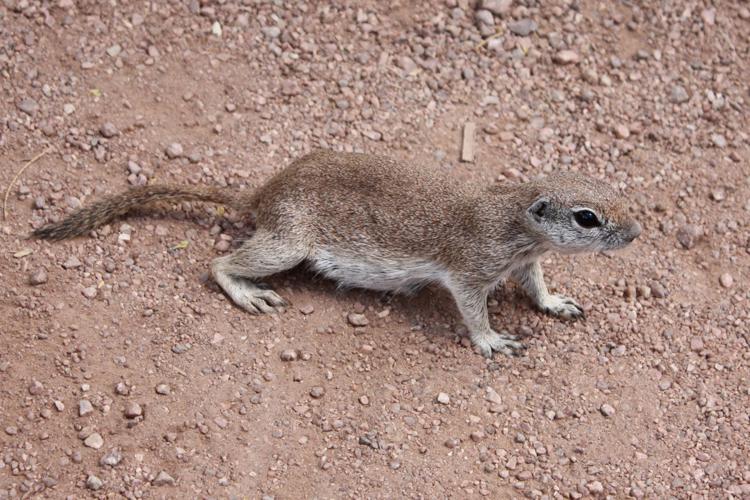Question: I have heard from a number of people that mistletoe does not kill a tree. That might be true, but it weakens the tree so much that anything that comes along after the infestation of mistletoe will kill the tree—like our drought. I think people want to hear that it doesn’t kill the tree so they don’t have to act on ridding the tree of it. Or maybe people don’t care that much about their trees. Even the Rillito River Path trees have a lot of it in them, and the city pays to plant and water the trees.
Answer: There are many species of mistletoe and they are parasitic plants. In general, the species we are familiar with in the low elevations of the Sonoran Desert attach to their host plant to absorb water and nutrients. The healthier the host plant, the healthier the parasitic mistletoe that depends on it. If the host plant is suffering from other problems, such as drought, the mistletoe can take enough water and nutrients to weaken the host and that can lead to the death of the host. A common species in our area is called mesquite mistletoe (Phoradendron californicum). This is a native plant that has a place in our desert ecology in that it provides food and shelter for some animals. The birds that eat the seeds will spread mistletoe by pooping them out in other trees along with a dollop of their own brand of fertilizer. It would be impossible to eradicate mistletoe from our environment because it of the way it is spread by birds. It would also be hard to generalize about the relationship between people and mistletoe. I am fairly certain there are a few different reasons why mistletoe is allowed to thrive on landscape trees. Depending on the person, these may include the knowledge that it is food for birds, that it’s not always easy or affordable to cut it out of every tree, and that there is an endless supply of this plant in the open desert from which it can spread. I am familiar with the city’s lack of resources and I expect they are doing the best they can with limited staff and funds to manage trees and other plants on public property.
Question:My father has a tangelo tree that will sometimes have a second bloom in the summer. This year on one of the branches there are two grapefruit! Usually I would think if there is another fruit it would come from a branch that sprouted from below the graft but this did not. He picked and cut one open and the flesh was a very light orange and tasted like a bland tangelo.
Answer:The tangelo is a hybrid citrus created by crossing a tangerine with a pomelo or grapefruit. Occasionally hybrids or part of them revert back to one of the original parents by producing plant parts such as foliage, flowers, or fruit that more resemble the parent plants. These growths are sometimes referred to as a ‘sport.’ So the odd fruit is likely a sport but probably something other than a pure grapefruit. Hopefully, they taste good. If not, you can prune that branch it out of the tree or just let it be.
Question: How can I get rid of the squirrels that are destroying my backyard? They have three huge (apparently connecting) holes around the large palo verde tree. They keep the gravel all messed up with their digging. Of course, my cat (who is an indoor cat) loves watching them from the door. The chipmunks have many holes around a large cholla on the bank outside the front wall, so I assume that is where they are coming from.
Answer: Round-tailed ground squirrels are not likely something you can eradicate. As you noticed, they can migrate from outside a wall by digging or climbing if it’s not made of slippery material. The best strategy is an integrated approach that includes systematic destruction of their habitat, trapping to reduce the population, and protecting the plants you like best with some sort of fencing. Since they are fairly small, using hardware cloth with smaller holes that can be buried a few inches into the soil may help. Since they climb, this means you also have to protect from that likelihood with either a cover or lining your barrier with flashing or some other material on which they cannot get traction. You can contain them but you can’t stop them.






